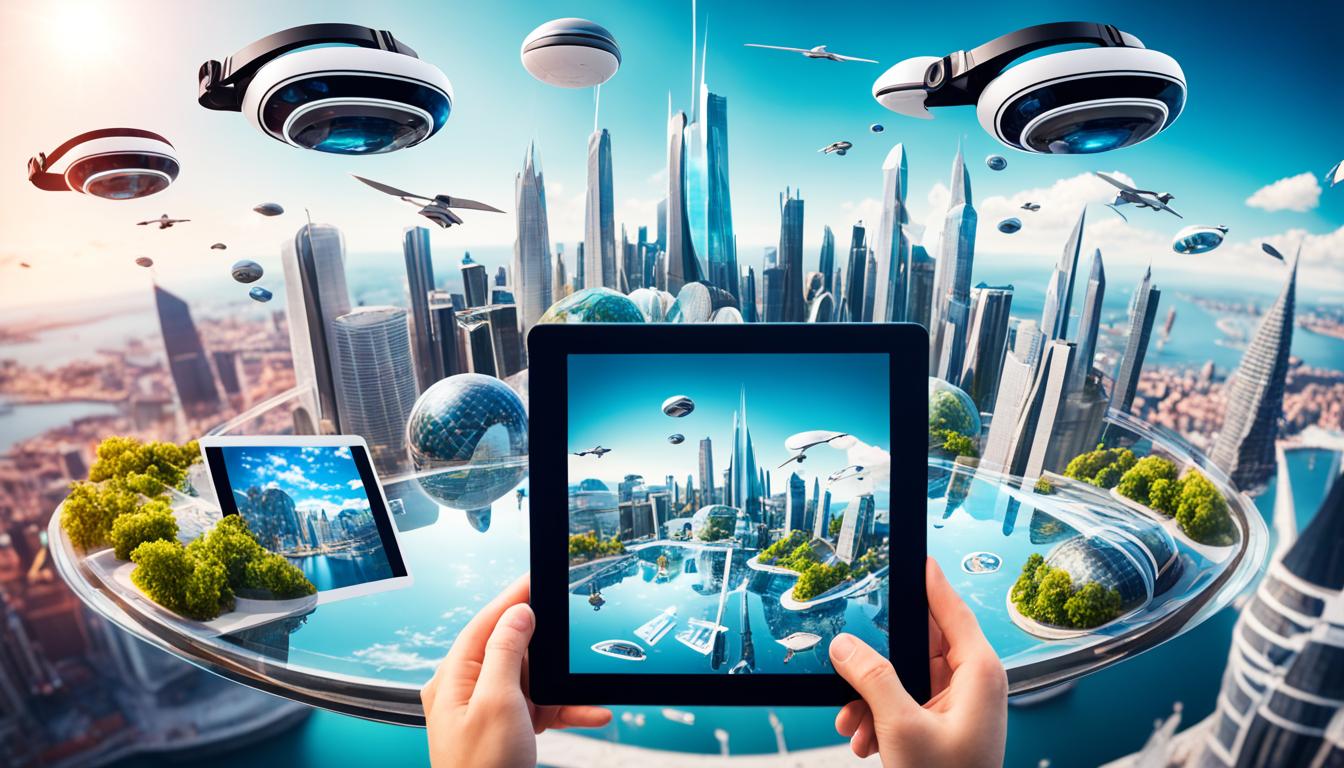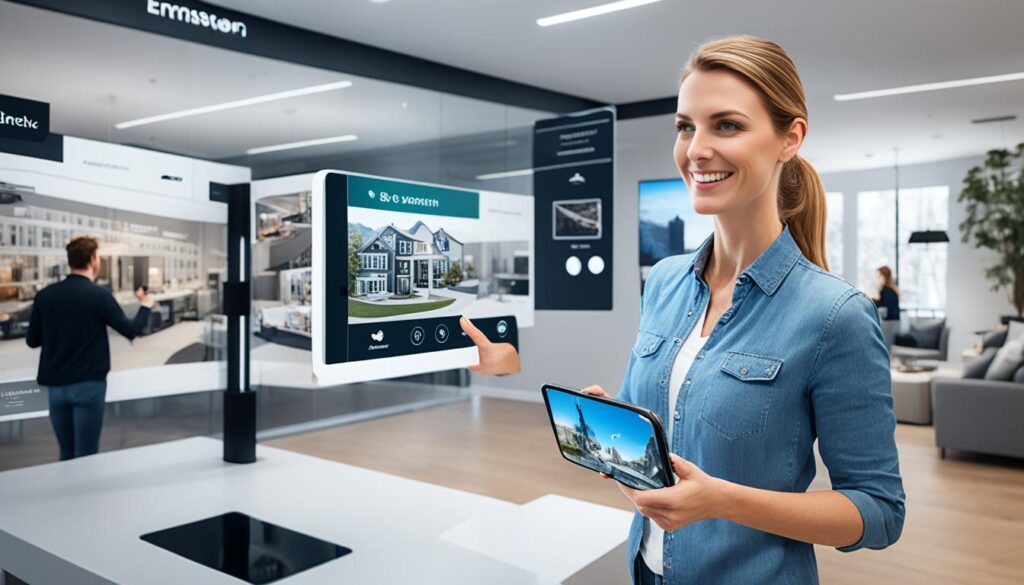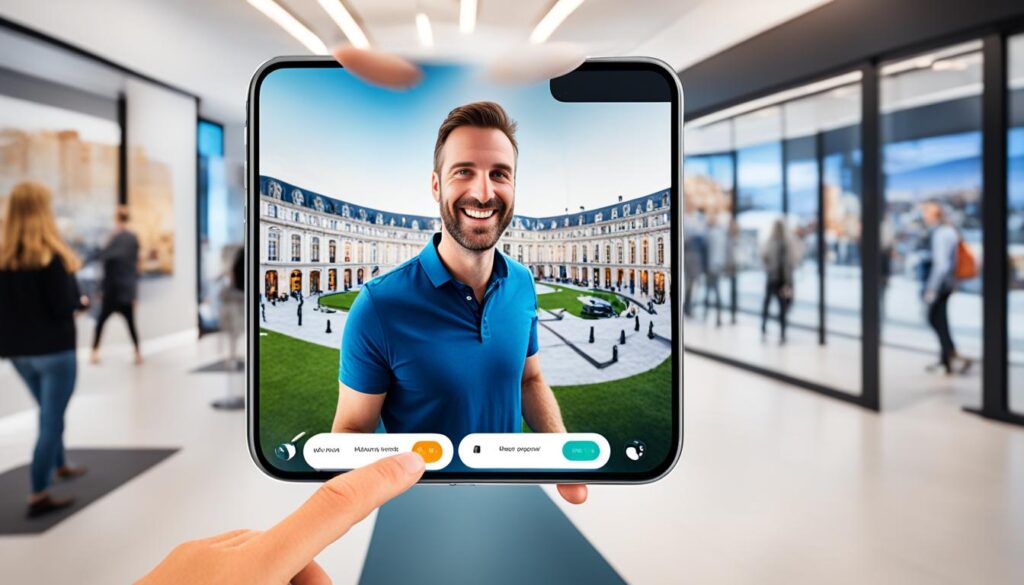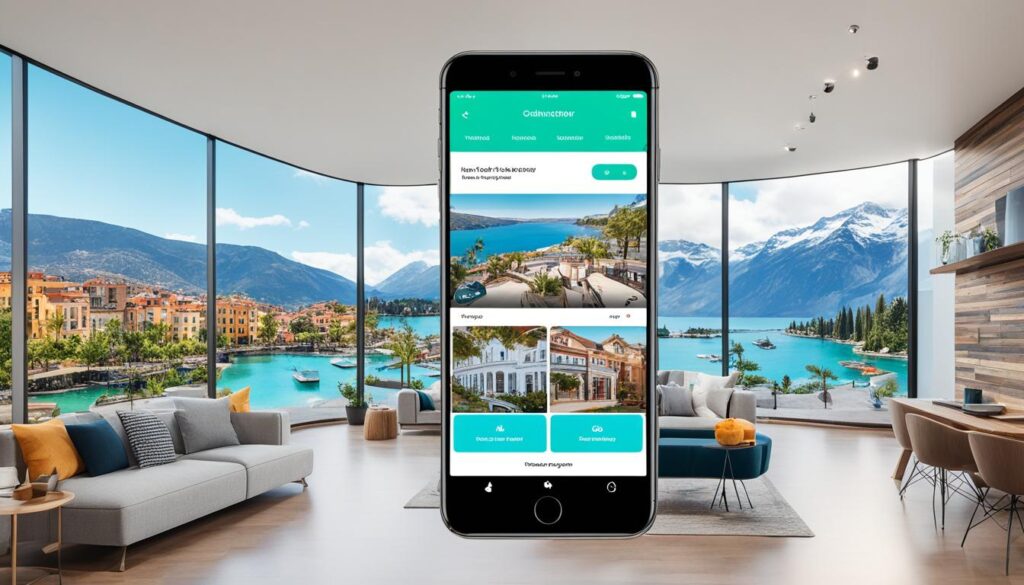The digital world is changing fast, making immersive virtual tours more popular than ever. Businesses want to grab their audience’s attention. That’s why designing great virtual tour apps is key to success. This guide will show you the must-have features and new tech to make your apps stand out.
We’ll talk about using 360-degree panoramic views and making tours interactive and easy to navigate. We’ll also look at the newest tech like Augmented Reality (AR) that’s changing how we explore online.
If you’re into business, marketing, or tech, this guide has what you need. It will give you tips and strategies to make your virtual tour apps amazing. Get ready to explore immersive virtual tours and learn about the features and tech that will take your digital experiences to the next level.
Table of Contents
Key Takeaways
- Discover the essential features for designing captivating virtual tour apps
- Explore the latest technological advancements that are revolutionizing virtual tours
- Learn how to create seamless and user-friendly virtual tour experiences
- Understand the importance of optimizing virtual tour apps for multiple devices
- Leverage virtual tour apps to enhance your marketing and branding strategies
Unleashing the Power of Immersive Virtual Tours
The rise of virtual tour apps has changed how businesses show off what they offer. These tools let customers check out products, services, and places from anywhere. The need for virtual tour technology has grown because people want smooth, fun, and engaging online experiences.
The Rise of Virtual Tour Apps
As what people want changes, businesses aim to give them memorable online experiences. Virtual tour apps are a big hit, letting companies show off their spaces and offerings in a cool way. These apps use the latest tech to make immersive virtual tours. This brings users right into the action, making them feel closer to the brand.
Benefits of Virtual Tours for Businesses
- Increased customer engagement and brand awareness
- Enhanced sales conversions and lead generation
- Improved customer decision-making and satisfaction
- Reduced physical barriers and increased accessibility
- Streamlined marketing and promotional efforts
By using virtual tour apps, businesses can open up new chances to grab their audience’s attention, boost sales, and make their mark online. As more people want deep, engaging experiences, smart companies are using the newest virtual tour technology to stand out.
User Experience: The Cornerstone of Captivating Virtual Tours
Creating a great virtual tour is key to keeping users interested and coming back. To grab users, designers focus on making tours that are easy to use, fun, and full of surprises.
At the core of a good virtual tour is easy navigation. Users should move through the tour smoothly, jumping from one spot to another without trouble. Clear signs and easy controls help guide them, making them feel in charge of their journey.
But it’s not just about moving around. The design should make users want to interact. With special spots, extra info, and things to click on, users get to dive deeper into the tour. This makes the experience better and helps share important details and show off the place.
The goal of a virtual tour is to amaze and thrill users. By focusing on what users want, developers can make tours that take users on amazing journeys. This leaves a strong impression and makes users want to come back.
| Key Principles of User-Centric Virtual Tour Design | Benefits |
|---|---|
| Intuitive Navigation | Seamless exploration, enhanced sense of control |
| Interactive Elements | Increased engagement, improved information retention |
| Immersive Visuals | Captivating user experience, sense of presence |
“The true magic of virtual tours lies in their ability to transport users to new and exciting environments, leaving them with a sense of wonder and a desire to explore further.”
By using these ideas, designers can make tours that really grab users. This leads to more engagement, keeps users coming back, and makes a big impact.
How to Design Virtual Tour Apps That Wow
Making a virtual tour app that catches the eye needs careful design work. To make it truly stand out, focus on three main areas: visual storytelling, interactive features, and technical optimization.
Visual Storytelling
Your virtual tour app’s look is crucial. Use top-notch panoramic images, professional videos, and smooth transitions to pull users into the virtual world. Choose camera angles and lighting carefully, and use editing to tell a beautiful story.
Interactive Features
- Use easy-to-use navigation tools so users can move around easily.
- Add interactive hotspots that reveal more info, multimedia, or links.
- Let users touch or interact with virtual objects or places for a deeper connection.
Technical Optimization
Make sure your app works well on different devices and platforms. This means having a responsive design, quick loading of assets, and smooth moves between views. Testing and improving your app is key to a great user experience.
By following these key design tips, you can make a virtual tour app that wows your audience. This will make your brand shine online.
“Designing a virtual tour app that truly immerses users requires a harmonious blend of visual storytelling, interactive features, and technical finesse.”
Key Features for Engaging Virtual Tour Apps
Creating engaging virtual tour apps means focusing on key features. These include 360-degree panoramic views and interactive hotspots with easy navigation. Both are vital for pulling users into virtual worlds.
360-Degree Panoramic Views
Apps with 360-degree panoramic views let users dive into the action from all angles. They feel like they’re really there, thanks to these detailed views. This makes the experience unforgettable, keeping users hooked and making it more memorable.
Interactive Hotspots and Navigation
It’s not just about the views. Apps need to be easy to navigate too. With interactive hotspots, users can check out different parts at their own speed. This makes the app more fun and encourages users to look around more, making them happier with their experience.
By adding 360-degree panoramic views and interactive hotspots with smooth navigation, virtual tour apps can really stand out. They offer an experience that’s both immersive and memorable.
“Virtual tour apps that offer a truly immersive experience, complete with panoramic views and intuitive navigation, are the ones that truly wow and engage users.”
Cutting-Edge Innovations in Virtual Tour Technology
The virtual tour industry is always changing, with new tech making big leaps. Augmented reality (AR) is one such innovation changing how we experience virtual tours. It mixes digital stuff with the real world, making tours more immersive and interactive.
Augmented Reality (AR) Integration
Augmented reality virtual tours let users see a space and interact with digital info. This can be info panels, 3D models, or virtual products. These add to the user’s understanding and make the tour more engaging.
The AR integration in virtual tours opens up new chances for businesses. Imagine showing off products in a virtual showroom or letting customers try furniture at home before buying. The potential for virtual tour technology innovations to change how we use digital content is thrilling.
As augmented reality virtual tours get better, the virtual tour industry is set to become even more engaging. With features like interactive hotspots and dynamic 3D models, the future looks bright. AR integration is a big part of this exciting change.
Creating Seamless Virtual Tour Experiences
Creating a smooth virtual tour is key to keeping users happy and interested. It’s important to make sure the app works well, moves smoothly, and pulls the user into the experience. This way, businesses can grab their audience’s attention and make a strong impression.
One big part of a great virtual tour is making it easy for users. This means designing the app so it’s easy to use and flows well. Things like clear directions, easy controls, and quick responses help keep users hooked on the tour.
Also, how well the app performs is crucial. Nothing ruins a tour like slow loading or choppy videos. To avoid this, make sure the app loads fast, uses efficient video encoding, and uses the right hardware to speed things up.
By focusing on making virtual tours smooth and enjoyable, businesses can make a big impact. With the right design and performance, every part of the tour should work together to keep users coming back for more.
“Creating a virtual tour that feels effortless and natural is key to keeping users engaged and coming back for more.”
Optimizing Virtual Tour Apps for Multiple Devices
Virtual tour apps are changing fast, making sure they work well on many devices is key. From computers to phones and tablets, virtual tour app responsive design and being easy to use on different devices are must-haves. This helps businesses connect with their audience better.
Responsive Design for Mobile Devices
More people use mobile devices to check out virtual tours. Responsive design for these apps is crucial. It lets users enjoy immersive experiences anywhere. By making the app work well on small screens, businesses make sure their tours are smooth and fun, no matter the device.
Designers focus on what mobile users want first when making these apps. They make sure touch controls work well, load times are quick, and visuals fit on small screens. This keeps the virtual tour experience great.
| Feature | Desktop | Mobile |
|---|---|---|
| Resolution | High | Responsive |
| Navigation | Mouse-based | Touch-based |
| Load Times | Moderate | Fast |
| Content Presentation | Expansive | Concise |
By making sure virtual tour apps work on many devices, businesses can reach more people. This lets users check out tours on their favorite devices, whether at home, on the move, or anywhere else.
“Responsive design is no longer a luxury, but a necessity for virtual tour apps in the modern digital landscape.”
Leveraging Virtual Reality (VR) for Immersive Tours
Virtual reality (VR) technology has changed how we experience tours. Now, businesses can offer customers a deep and engaging experience with VR in tour apps.
VR makes users feel like they are really there, making the experience more real. This can make customers feel a stronger connection to the brand. It also makes them happier with their experience.
Using virtual reality virtual tours lets businesses show off what they offer in a new way. Imagine taking customers right to your store or hotel lobby with a immersive VR experience.
Enhancing Engagement through VR
VR integration in virtual tour apps creates a unique level of immersion. Users can move around and interact with things in the digital space. It’s like they’re really there.
- Enhance user engagement and retention
- Provide a more memorable and impactful brand experience
- Differentiate your offerings from competitors
- Showcase your products or services in a captivating and innovative way
As more people want virtual reality virtual tours, businesses that use this tech will stand out. They’ll grab and keep their customers’ attention.
“VR has the power to transport users to a completely different world, creating a sense of presence that was once thought impossible. By integrating this technology into virtual tour apps, businesses can unlock a new level of customer engagement and brand loyalty.”
Using virtual reality virtual tours and immersive VR experiences can change your business. It can take your tours to new levels of innovation and customer happiness.
Integrating Virtual Tours with Marketing Strategies
Virtual tour apps are now key marketing tools. They let businesses show off their products, services, or places in a fun and real way. By adding virtual tours to marketing plans, companies can use these new tech to get more leads, make their brand more known, and engage with customers better.
Using virtual tours as a lead generation tool is a smart move. They let potential customers check out what a business offers in an interactive way. This way, companies can get important contact info and find high-quality leads. It shows the brand cares about giving a great customer experience.
Virtual tours also help with brand awareness. They give a beautiful and engaging look at a business’s place or products. This makes a strong impression on potential customers, making the brand more memorable. It works well with other marketing like social media or online ads.
Also, virtual tours make customers more engaged by offering a deep and interactive look at what a business offers. Customers can look around at their own speed, feeling more connected and valued. This leads to more loyalty and happiness from customers.
To make the most of virtual tours in marketing, businesses need to blend these new tech into their marketing plans well. This means having a clear content plan, making sure the virtual tour works well on different devices, and looking at how users interact to make things better.
By using virtual tours in marketing, businesses can stand out, get quality leads, and build stronger connections with their audience. As more people want new and engaging marketing, virtual tours will keep getting more important in digital marketing.
Best Practices for Virtual Tour Content Creation
Making virtual tour content that grabs users’ attention needs a careful approach to photography and videography. It’s key to make high-quality, eye-catching virtual tour assets. This helps users feel like they’re really there.
High-Quality Virtual Tour Photography
Great virtual tour photography is the heart of a good virtual tour. Here are some tips to keep in mind:
- Use top-notch cameras and lenses for clear, detailed images.
- Focus on lighting to get the right brightness and contrast.
- Try different angles to show the space from many views.
- Edit and enhance the images to make them pop with color and clarity.
Professional Virtual Tour Videography
Virtual tour videography is also key for a deep dive into the experience. Here’s how to make your videos stand out:
- Choose quality video gear, like 360-degree cameras or drones, for smooth footage.
- Use smooth camera moves and transitions to keep the viewer engaged.
- Show off the space with dynamic angles and details.
- Make sure the audio is clear, either by recording on-site or editing later.
Following these tips for virtual tour content creation helps businesses make virtual tours that really wow users.
“Attention to detail is the key to creating a virtual tour that truly immerses the user in the space.”
Virtual Tour Analytics and User Engagement Tracking
It’s key to track how well virtual tour apps do and how users interact with them. By looking at virtual tour app analytics and virtual tour user engagement metrics, companies can learn a lot. This helps them make their virtual tours better and improve the experience for users.
One important thing to watch is how much users interact and engage with the tour. This means keeping an eye on how long they stay, what they click on, and how they move through the tour. Knowing this helps make future tours more engaging and fun.
Also, it’s vital to see how tours convert users into customers. This means looking at who finishes the tour, who wants more info, or who buys something. By linking these numbers to what users do, companies can find the best ways to get people involved and buying things.
Using advanced tools gives a clearer picture of how tours are doing. Tools like heatmaps, recordings of user sessions, and A/B testing help show what users like and what they don’t. By looking at this data often and using it to improve the tours, companies can keep making things better for users.
In the end, virtual tour analytics and user engagement tracking are key for companies. They help make smart, data-driven virtual tour optimization choices. This way, companies can connect with their audience better and get real results.
The Future of Virtual Tour Apps: Emerging Trends and Innovations
The virtual tour industry is set for a big change, with new technologies ready to change how we experience them. We’re looking at innovations that will shape the future of virtual tour apps.
AI and computer vision are big news for virtual tour apps. They will make tours more personal and smart, adjusting to what you like and do. Imagine tours that show you what’s interesting just by watching where you look or tell you cool facts about what’s around you.
Spatial computing, a mix of AR and VR, is also changing the game. It lets users move easily between the real and digital worlds. This means a more real and fun experience in virtual tours.
| Emerging Trend | Impact on Virtual Tour Apps |
|---|---|
| Artificial Intelligence (AI) and Computer Vision | Enhanced personalization, intelligent highlighting of points of interest, and real-time contextual information |
| Spatial Computing (AR/VR) | Seamless integration of digital and physical environments, creating a more immersive and interactive virtual tour experience |
| Haptic Feedback and Tactile Interactions | Enabling users to physically feel and interact with virtual objects, adding a new dimension to the virtual tour experience |
Adding haptic feedback and tactile interactions will change how we use virtual tour apps. You’ll be able to touch and feel things in the virtual world, like touching a museum piece or feeling a building’s shape. This adds a new level to exploring.
As virtual tours keep getting better, these new trends and innovations will shape their future. They promise more immersive, personal, and fun experiences for users in many areas.
Conclusion
Creating virtual tour apps that grab users’ attention is all about mixing new tech, focusing on users, and knowing the market. This guide has shared key tips and best practices. With these, businesses can make apps that are fun, engaging, and set them up for success in the digital world.
For making great virtual tour apps, use 360-degree views, interactive spots, and augmented reality. Make sure your app works on different devices and fits with your marketing plans. Also, track how users interact with your app to make it even better.
As more people want virtual tours, companies that use virtual tour app design well will shine. They’ll give customers an experience they won’t forget. By keeping up with new tech in virtual tours, businesses can grow, engage more with customers, and achieve success.














